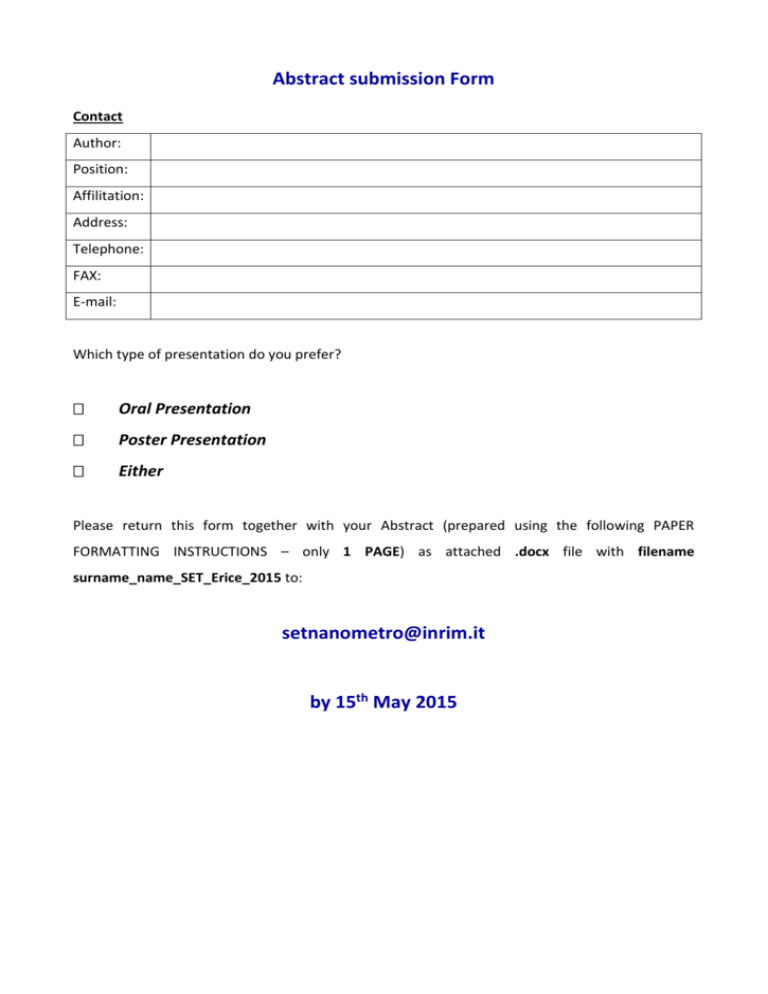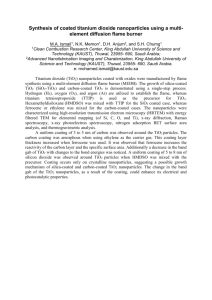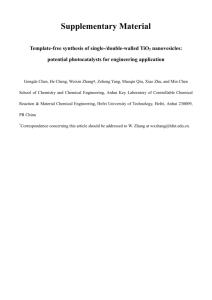Abstract Submission Form
advertisement

Abstract submission Form Contact Author: Position: Affilitation: Address: Telephone: FAX: E-mail: Which type of presentation do you prefer? Oral Presentation Poster Presentation Either Please return this form together with your Abstract (prepared using the following PAPER FORMATTING INSTRUCTIONS – only 1 PAGE) as attached .docx file with filename surname_name_SET_Erice_2015 to: setnanometro@inrim.it by 15th May 2015 (CODE, ASSIGNED BY THE ORGANIZERS) TITLE OF PAPER Authors Affiliation, address, email of the presenting Author. For different affiliation, use alphanumerical superscript ABSTRACT …text… see the example below REFERENCES ….text references…. see the example below EXAMPLE TiO2 NANOPARTICLES WITH CONTROLLED SHAPE AND TiO2 P25: ELUCIDATION OD THE STRUCTURE OF SURFACE CATIONS Chiara Deiana,a,b Marco Minella,a Gloria Tabacchi,b Valter Maurino,a Ettore Fois,b Salvatore Coluccia,a and Gianmario Martra,a (chiara.deiana@unito.it) a)Department of Chemistry, University of Torino, Via P. Giuria 7, 10125, Torino, Italy. b)Department of Science and High Technology, University of Insubria, Via Lucini 3, 22100 Como, Italy. ABSTRACT TiO2 photocatalytic behavior is affected to a large extent by surface structure and interactions with adsorbed molecules on TiO2 nanoparticles [1-3] Spectroscopic methods are very effective tools for unraveling structure and reactivity of surface sites of oxides. In particular, the possibility to attain a comparison at a “molecular resolution” level between the surface features of nanoparticles with well shaped or irregular surfaces is offered by the IR spectroscopic studies of adsorbed probe molecules exhibiting vibrational features sensitive to the nature and structure of adsorbing sites. As well known, this is the case of the frequency of the internal stretching mode of adsorbed CO, that can be used to probe a broad variety of systems, from single crystals to finely divided powders.[4,5] Now, integrated studies of CO on truncated bipyramidal TiO2 anatase nanoparticles mainly enclosed by (101) and (001) type facets, provide the missing link between TiO2 single crystals and commercial TiO2 nanopowders with complex morphology.[3] On such a basis, well-shaped titania nanoparticles were prepared in selected hydrothermal conditions (hereafter referred to as TiO2 HT). The synergy among high resolution transmission electron microscopy, IR spectroscopy and modeling correlates adsorbed CO stretching frequency to anatase surface type and elucidates key aspects of the reactivity of TiO2 P25, one of the most adopted titania photocatalysts. Comparison of the two TiO2 nanoparticle types highlights the role of low coordination Ti4+ sites selectively present on TiO2 P25 in the photocatalytic decomposition of H2O2, an important Reactive Oxygen Species (ROS) formed in photocatalytic processes.[6] Such a powerful multi-disciplinary approach provided a significant advance in the understanding of the interactions of molecules at TiO2 surfaces, which allowed to correlate observed properties with Figure1. Infrared spectra of CO adsorbed on TiO2 HT. Top inset right: 3D model of TiO2 HT specific structural features of the nanoparticles. nanoparticles. Bottom inset: model of CO adsorbed on TiO2 anatase (101) slab. REFERENCES [1] Gong, X. Q.; Selloni, A. J. Catal. 2007, 249, 134-139. [2] Augugliaro, V.; Coluccia, S.; Garcia-Lopez, E.; Loddo, V.; Marci, G.; Martra, G.; Palmisano, L.; Schiavello, M. Top. Catal. 2005, 35, 237-244. [3] D'Arienzo, M.; Carbajo, J.; Bahamonde, A.; Crippa, M.; Polizzi, S.; Scotti, R.; Wahba, L.; Morazzoni, F. J. Am. Chem. Soc. 2011, 133, 17652-17661. [4] Hadjiivanov, K. I.; Vayssilov, G. N. Adv. Catal. 2002, 47, 307-511. [5] Spoto, G.; Gribov, E.; Damin, A.; Ricchiardi, G.; Zecchina, A. Surf. Sci. 2003, 540, L605-L610. [6] Maurino, V.; Minero, C.; Mariella, G.; Pelizzetti, E. Chem. Commun. 2005, 2627-2629.








